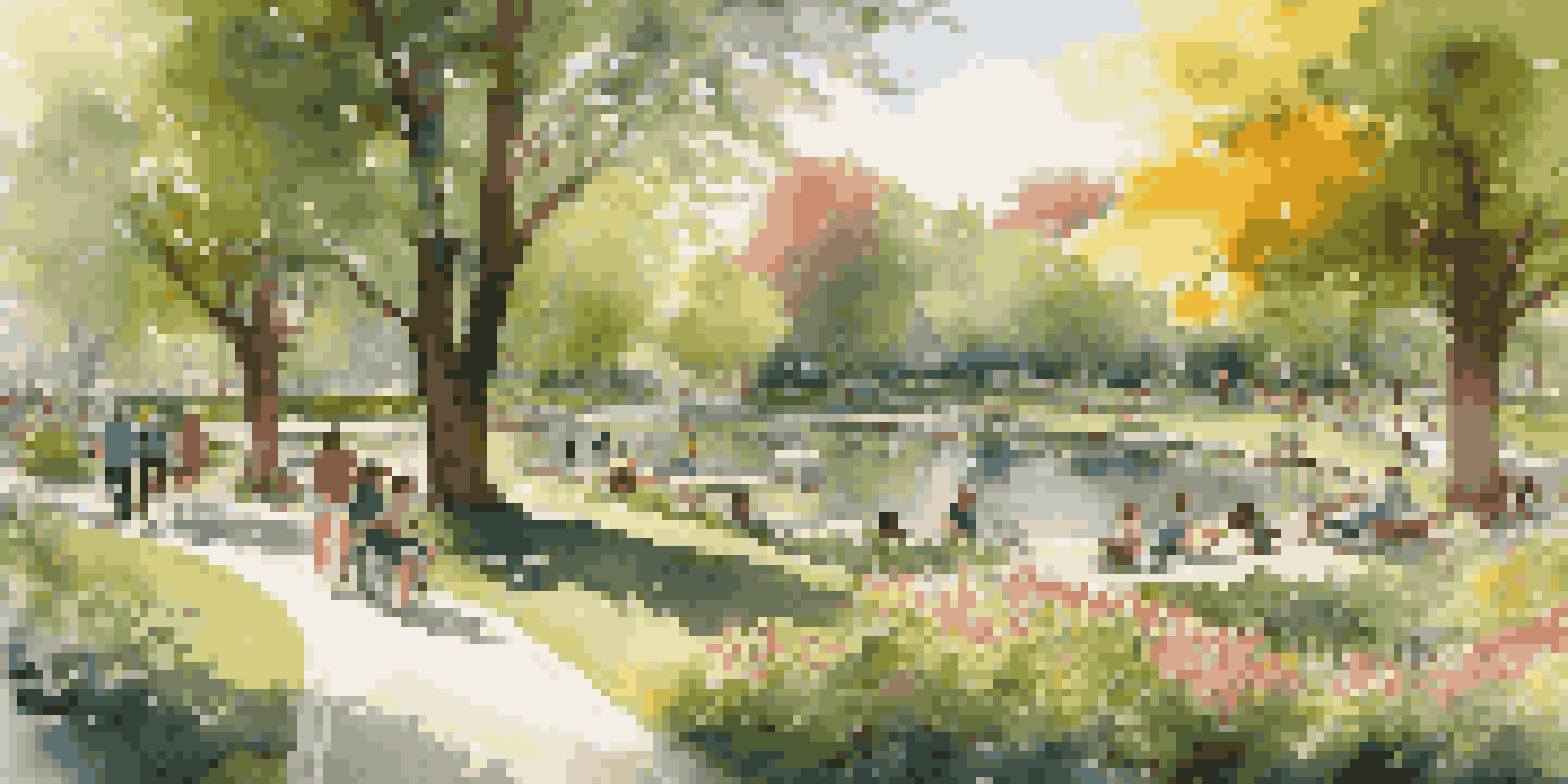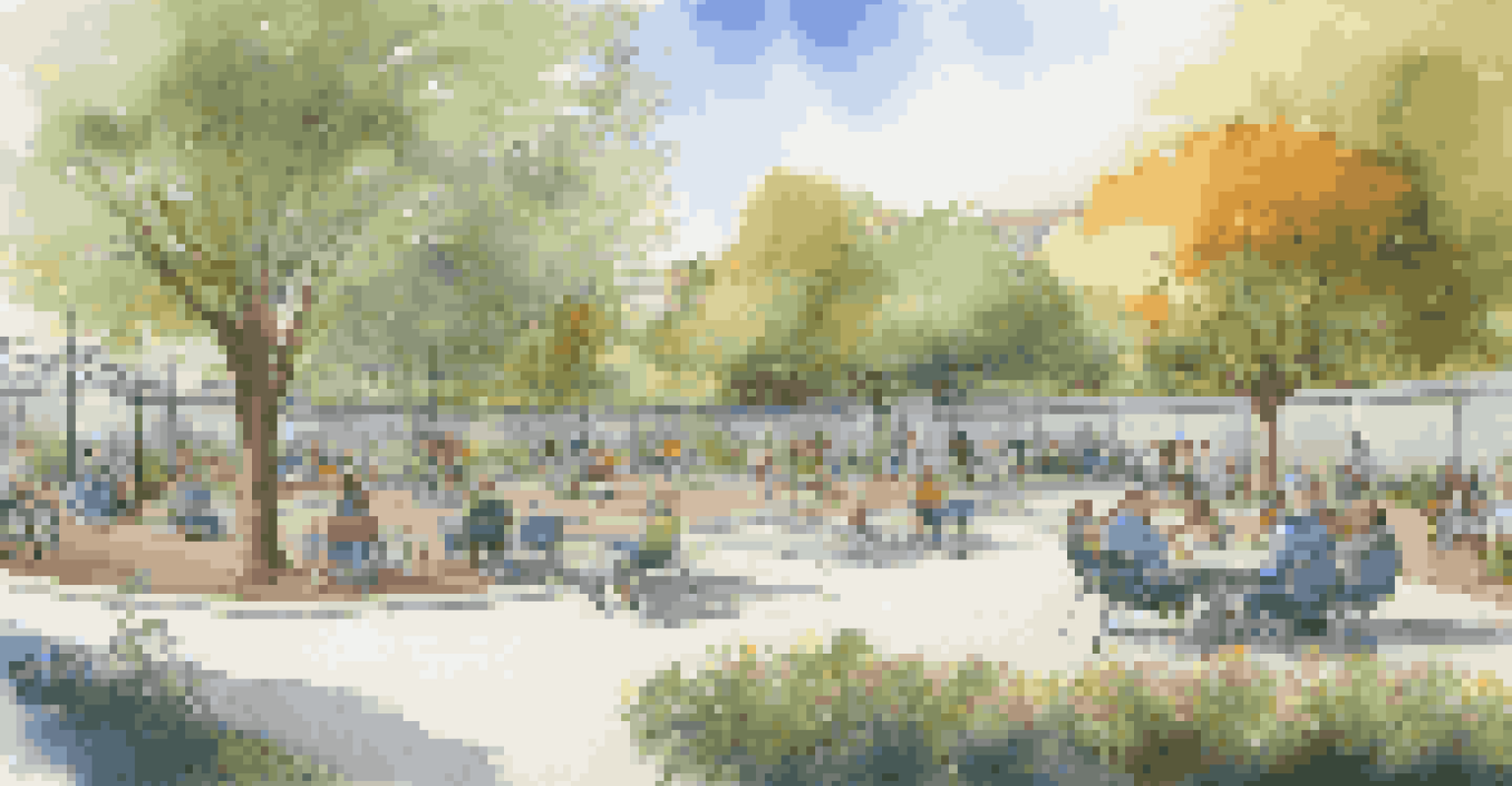Urban Living: The Importance of Outdoor Spaces in Cities

The Role of Outdoor Spaces in Urban Environments
Outdoor spaces play a crucial role in urban environments, serving as vital lungs for cities filled with bustling activity. Parks, plazas, and gardens provide a necessary respite from the concrete jungle, allowing city dwellers to connect with nature. They not only enhance the aesthetic appeal of the urban landscape but also improve air quality and promote biodiversity.
Parks and public spaces are the lungs of the city, providing not only a breath of fresh air but also a sense of community and belonging.
More than just a place to relax, these outdoor areas encourage social interaction and community bonding. They offer a venue for events, gatherings, and activities that help cultivate a sense of belonging among residents. This social aspect is essential, especially in densely populated areas where personal connections can often feel strained.
Moreover, outdoor spaces can positively impact mental health and well-being. Studies show that spending time in nature reduces stress, enhances mood, and boosts overall happiness. For urban residents, access to these green spaces can be a lifeline, providing moments of tranquility amidst the chaos of city life.
Benefits of Green Spaces for Urban Health
Green spaces are not just beautiful; they are beneficial for our health. Access to parks and gardens encourages physical activity, whether it's jogging, walking, or playing sports. A simple stroll in a park can increase cardiovascular health, promote weight management, and improve overall fitness levels.

Additionally, these spaces contribute to mental well-being by offering a sanctuary for relaxation and reflection. The calming effect of greenery can lower anxiety and depression, making it essential for urban dwellers who often face the stresses of city living. Just a few minutes in nature can revitalize the mind and spirit.
Urban Green Spaces Enhance Health
Access to parks and gardens promotes physical activity and mental well-being for city residents.
Furthermore, green spaces can enhance social health by serving as venues for community activities and gatherings. They promote inclusivity, allowing people from different backgrounds to come together, share experiences, and foster friendships. This sense of community is vital for creating a supportive urban environment.
Environmental Impact of Urban Green Spaces
Urban green spaces play a significant role in combating environmental issues within cities. They help mitigate the urban heat island effect by cooling the air and providing shade, which is crucial as climate change continues to affect weather patterns. This cooling effect can lead to reduced energy consumption in nearby buildings.
Green spaces are not just a luxury; they are essential for the health and well-being of urban populations.
In addition to cooling, these spaces also improve air quality by filtering pollutants and producing oxygen. Trees and plants absorb carbon dioxide and release oxygen, making them vital allies in the fight against urban pollution. This natural filtration system is particularly important in densely populated areas where air quality can suffer.
Moreover, urban green spaces support biodiversity by providing habitats for various species. They act as vital corridors for wildlife, allowing flora and fauna to thrive even in urban settings. By preserving these ecosystems, cities can foster a healthier environment for both people and nature.
Designing Inclusive Outdoor Spaces
Creating inclusive outdoor spaces is essential for fostering a sense of belonging among all city residents. This means designing parks and gardens that cater to diverse needs, including accessibility for individuals with disabilities, children, and the elderly. Thoughtful design can ensure that everyone can enjoy and benefit from these spaces.
Moreover, incorporating cultural elements into outdoor spaces can enhance their appeal and relevance to different communities. This might include art installations, community gardens, or performance areas that reflect the local culture and history. Such features can create a stronger connection between residents and their outdoor environments.
Sustainable Design for Future Cities
Incorporating eco-friendly features in outdoor spaces fosters biodiversity and supports urban resilience.
Engaging the community in the design process is another crucial step. By soliciting input from residents, cities can create spaces that truly reflect the needs and desires of their populations. This participatory approach not only leads to better designs but also fosters a sense of ownership and pride among community members.
The Economic Value of Outdoor Spaces
Outdoor spaces can significantly boost the local economy, attracting visitors and residents alike. Well-designed parks and recreational areas increase property values and make neighborhoods more desirable, leading to higher demand and investment. This economic uplift can create jobs and enhance local businesses.
Furthermore, outdoor spaces can serve as venues for events, markets, and festivals, drawing in crowds and generating revenue for the community. These activities not only provide entertainment but also foster local culture and support small businesses, contributing to a vibrant urban economy.
Investing in outdoor spaces is not just a cost; it’s an investment in the future of the city. Cities that prioritize green spaces often see long-term economic benefits, including increased tourism, higher property values, and a more engaged community. This cycle of growth reinforces the importance of outdoor spaces in urban planning.
Challenges in Maintaining Urban Outdoor Spaces
Despite their importance, maintaining outdoor spaces in urban areas poses several challenges. Limited funding, vandalism, and neglect can lead to deterioration, impacting their usability and appeal. Cities often struggle to allocate enough resources for the upkeep of these essential areas.
Moreover, the increasing pressure of urban development can encroach on existing green spaces, leading to their reduction or even elimination. This loss can diminish the quality of life for residents and negatively impact the environment. Advocating for the preservation and expansion of these spaces is crucial in combating this trend.
Community Engagement is Key
Involving residents in the design and maintenance of outdoor spaces fosters a sense of ownership and pride.
Community involvement plays a key role in addressing these challenges. Engaging local residents in the maintenance and protection of outdoor spaces can foster a sense of responsibility and encourage stewardship. Volunteer programs and local initiatives can help ensure that these precious areas remain vibrant and accessible for everyone.
Future Trends in Urban Outdoor Spaces
As cities continue to evolve, so do the trends in designing outdoor spaces. Increasingly, urban planners are focusing on creating multifunctional spaces that serve multiple purposes, such as parks that can host events, markets, and recreational activities. This versatility can maximize the use of limited urban land.
Sustainability is also becoming a driving force in the design of outdoor spaces. Incorporating native plants, rain gardens, and green roofs can enhance biodiversity and improve environmental resilience. These eco-friendly designs not only benefit the environment but also educate residents about sustainable practices.

Lastly, technology is making its mark on urban outdoor spaces. Smart parks equipped with free Wi-Fi, charging stations, and interactive installations can enhance the user experience. As cities embrace innovation, the future of outdoor spaces holds exciting possibilities for enhancing urban living.